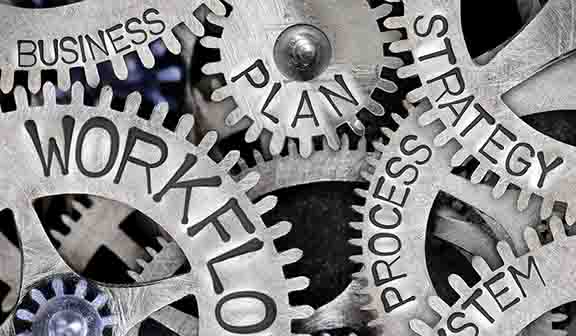Like life’s patterns, the maturity of reliability programs in a factory follows a cyclic process. The diagram above illustrates the most common stages that most plants currently occupy concerning their reliability maturity relative to maintenance costs. Your specific plant may not align precisely with one of the four identified levels; it might be in-between two phases.
Nevertheless, we aim to showcase the reliability cycle and highlight common errors that lead from an ideal scenario—where maintenance costs perfectly balance with reliability—to a worst-case situation where maintenance expenses skyrocket while the plant’s reliability plummets. It’s crucial to note that when referencing reliability in this context, it refers to how efficient the assets are at maintaining their operation at a high-performance level without any unplanned breakdown.
This article will analyze the 4 following scenarios:

Scenario 1: The Sweet Spot between Maintenance Costs and Reliability Performance
This is the level you want to aim for. As illustrated in the figure above, having a reliable plant comes at a certain cost. It is a cost that is significantly lower than a reactive plant. Indeed comparing worse case scenario, based on a study by Solomon Consulting group, maintenance cost can be 300-400% more depending on the industry sector your plant is in.
However, the key point here is that a reliable plant comes at a certain cost. As it can be seen in the figure above, indeed a reliable plant a less maintenance cost than a non-reliable reactive plant, however, it does not come for free. Often people will be under the impression that a reliable plant comes at no cost. Indeed, a reliable plant will be able to limit reactive maintenance, but it still requires a certain amount of money to address those unexpected breakdowns, continuous improvement projects, new technologies initiatives, etc. This whole assumption that a reliable plant comes a no cost often pushes a plant to downgrade to scenario #2.
Scenario 2: Reduce maintenance costs and hope to stay as reliable as scenario #1
Focusing solely on PM compliance is a positive step towards objectively quantifying preventive This scenario often emerges with new management, ownership transitions, or the introduction of new company values and mindsets. Seeking increased profitability, companies commonly resort to a simple solution: limit and cut the maintenance budget. Consequently, maintenance costs undergo a significant reduction, as depicted in the figure above. The new reliability projects will be put on hold, improvement projects will be cancelled, contractors will be sent home, maintenance overtime will be reduced, etc.
Initially, the plant manages to sustain a relatively high level of reliability and uptime performance due to the robust reliability fundamentals established in scenario 1. However, over time, as the plant’s reliability loses its central focus, degradation sets in gradually. At this point, the company appears highly profitable (maximized reliability, minimized maintenance cost), yet management and new ownership are aware that they’re teetering toward becoming scenario #3. This situation often coincides with new ownership or management transitions as the prior stakeholders aim to exit on a positive note, maximizing its investment, just before encountering significant challenges.
Scenario 3: What was meant to happen, happened
To begin with, consider the scenario where the scheduled workload exceeds the available It’s been a considerable period without investment in the plant’s reliability program and it is showing. Critical assets swiftly become unreliable, demanding constant reactive maintenance. In a survival mode, companies inject funds to manage unexpected failures, resulting in mostly reactive maintenance. A reactive plant faces escalated costs due to sudden breakdowns, heightened maintenance needs, and lost productivity from unplanned downtime.
The key takeaway here is that a significant amount of money is injected in terms of maintenance cost, but all this money is to address today’s issues. Referring to what was mentioned earlier, this scenario requires far higher expenses than in scenario #1 since a reactive plant is said to spend 3-4x what a reliable plant would spend for the same plant’s assets and configuration – but in the scenario, there is none forward-looking investment. This is the worst-case scenario.
Scenario #4: Heavy investment to get away from reactive maintenance
When you are in scenario #3, you must do something that is unthinkable: inject more money into the plant. At this point, constant requests for a new budget for reactive maintenance contractors on site, rush repairs initiatives are a norm at the site. However, when referring to injecting more money, it must be centered around the future reliability of the plant. It can not be around reactive maintenance projects. The key investment should tackle the reliability pillars of your plants and where the return is the greatest – criticality reassessment, CMMS master data validation for plant mins/max, and PM optimization program. Unsure where to begin? Take a step-back and define what is your existing level of maturity with respect to all reliability pillars and craft a concrete action plan to aim for top quartile reliability – even if it seems far-fetched at this point.
We understand that if you’re thinking of extra spending, it’s likely not on the fundamental reliability projects listed above but on exciting tools like a wireless vibration system or high-tech thermographic cameras. However, consider answering those questions: How will you decide where to deploy the new vibration system? If a failure is detected with the wireless vibration system, are the necessary parts in your inventory to do the repairs? Are the parts entered into the CMMS? How easily can you find it in your CMMS? What other maintenance strategies are deployed to cover the other failure-mode that is not covered by wireless vibration?
All those questions can be addressed when the reliability fundamentals are covered – updated asset criticality assessment, CMMS documented with standardized naming for the Master Equipment List and BOMs and optimize maintenance strategies based on failure code. We know, those projects are not the sexiest, but project after projects, if those reliability fundamentals pillars are not covered within your existing reliability program, you cannot expect to build on top of that. These are the basis of a reliable plant. Only plants with the proper reliability fundamentals in place can successfully deploy the new gadgets and technologies that are out there.

Reliability fundamentals
After investing money to boost your reliability program, you will be able to deploy the right maintenance strategies according to the asset’s criticality. This should lead to a significant improvement in the plant’s reliability. You will be able to uncover potential failure and address those prior to emergency break-ins. This should also lead to a notable enhancement in plant reliability, uncovering potential failures with your PM and PdM program and allow enough time to address those findings prior to emergency break-ins. Gradually gaining greater control over equipment health and performance, you’ll observe a decline in maintenance costs until achieving the ideal balance between a highly reliable plant and its maintenance expenses.

Arnaud Richer, B. Eng.
Reliability solutions – Spartakus technologies
arnaud.richer@spartakustech.com

